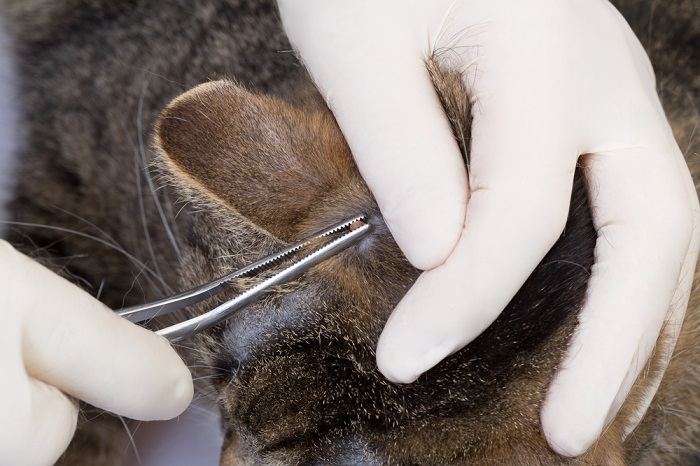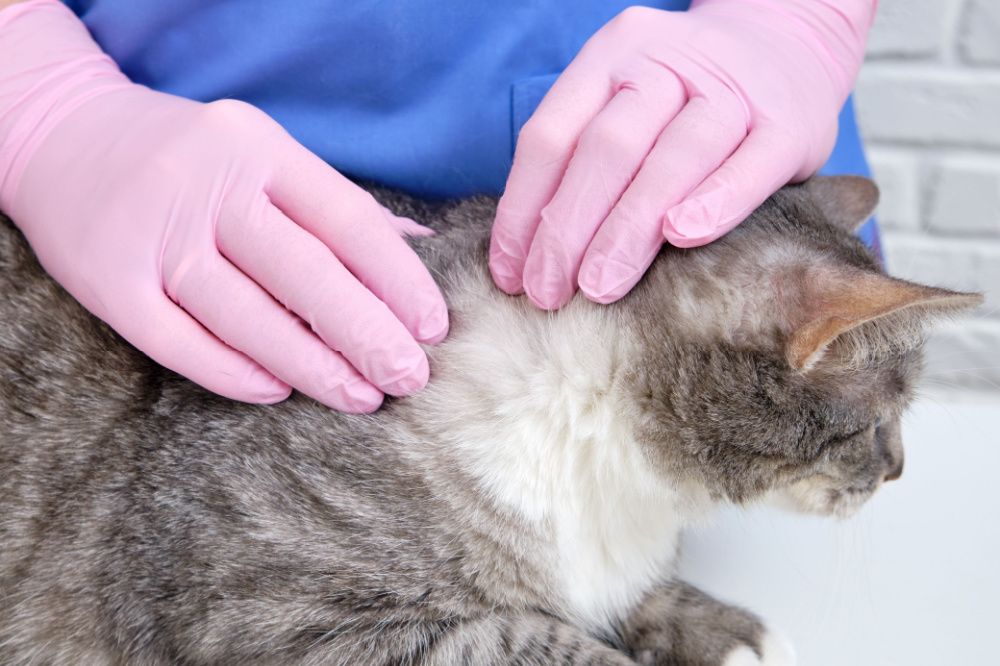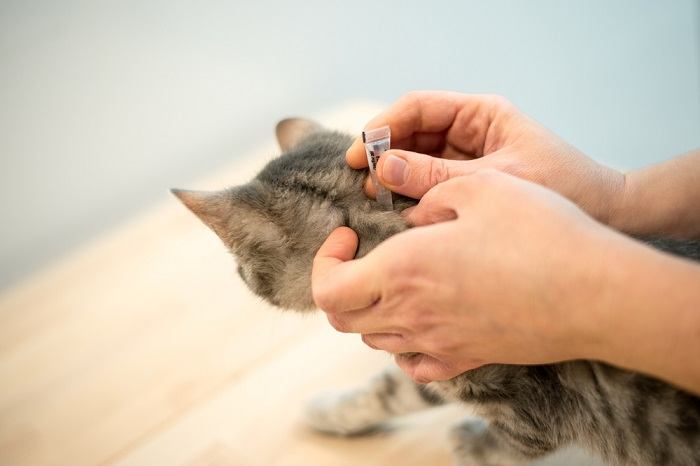
Ticks are pesky parasites that are commonly found in long leafy grasses and shaded woodland areas. They can be found in many outdoor areas and can affect cats, humans, and other pets.
Along with being irritating pests, ticks can also be very dangerous, as they spread tick-borne diseases that can make our cats (and us) sick.
Certain tick-borne diseases such as Lyme disease can even spread from an infected cat to humans, so extra care needs to be taken when it comes to ticks. In this article, we will discuss how to identify ticks and what you can do to treat them in this article.
What Are Ticks and What Do They Do?
Ticks are parasites that are part of the arachnid family, which includes spiders and scorpions. There are over 800 species of ticks worldwide so as you can imagine, they all look a little different from each other.
The one thing that all ticks will have in common is that they have eight legs and no antennae. Immature ticks (called larvae) have six legs. Ticks have four stages in their life cycle: egg, larva, nymph, and adult.
Ticks crawl (as opposed to jumping or flying) onto animals and people, attaching themselves when they bite. They then feed on the host’s blood for several days before they fall off. It’s during this feeding time that ticks can spread diseases into the host’s bloodstream.
Tickborne Diseases

Ticks should be removed carefully and as soon as possible, once they are spotted.
Even though there are 800 species of ticks worldwide, only a few are of concern to cats and humans. These include ticks such as the deer tick, the brown dog tick, the American dog tick, the lone star tick, the Rocky Mountain wood tick, the Gulf Coast tick, and the western black-legged tick. These ticks can spread diseases to our cats such as Lyme disease, hemobartonellosis, cytauxzoonosis, and tularemia. The latter two diseases carry a very poor prognosis and often prove fatal.
Lyme disease rarely affects cats, as they’re quite resistant to the infection. However, Lyme disease can spread to humans through ticks and it can cause debilitating disease. According to the Centers for Disease Control and Prevention, symptoms include:
- Fever
- Rash
- Facial paralysis
- Joint pain
- Headaches
- Heart palpitation
- Inflammation of the brain and spinal cord
- Nerve pain
Tick-borne diseases can spread in as little as 24 hours in a feeding tick and the chance increases the longer they’re feeding. This means that we should take action as soon as we see a tick on our cat and have it removed quickly.
How Cats Pick Up Ticks
Ticks are common in cats that go outdoors as ticks are found in areas with long grass and woodland. They are most active during the summer and autumn months.
Ticks often stay on leaves and long blades of grass and wait for an animal or human to brush past. They then crawl onto the host and attach themselves by biting the skin. This is called questing. This could easily happen as your cat is hunting or walking through long grass!
How To Check a Cat for Ticks
Unlike insects, ticks have eight legs and no antennae. There are generally two types of ticks: hard ticks and soft ticks. Hard ticks are most commonly found on cats and are flat and round when unfed.
Ticks become engorged after feeding. They often resemble a small lump or bump on your cat’s skin, so examine these carefully to check if it’s a tick before you try removing it.
What To Do if You See a Tick on Your Cat

If you see a tick on your cat it’s important to take it seriously and to act fast. The tick should be removed as soon as possible to prevent tick-borne diseases. You should wear gloves if you’re inspecting the area with the tick(s).
You can remove the tick yourself if you feel confident enough to do so correctly. If you are unsure or don’t feel confident in removing the tick yourself, contact your local veterinary clinic and they will remove the tick for you.
How to Safely Remove a Tick From a Cat
Removing a tick is an easy procedure and it can be done at home. You need to follow some simple steps in order to do this safely. To remove a tick, you will need a tick removal tool or tweezers, gloves, and a bowl containing alcohol to put the tick in once you’ve removed it.
It’s important to remove all of the tick and to not leave any of it behind in the cat’s skin. If some of the tick gets left embedded in the skin, it can cause inflammation, redness, and infection, which may require treatment from your veterinarian.
To remove the tick with tweezers, grasp it as close to the cat’s skin as possible, and then firmly pull the tick upwards. If you are using a tick removal tool, hook the tool underneath the tick and twist it upwards until the tick detaches.
Signs That Your Cat Is Sick From a Tick-Borne Disease
If your cat has a tick and it has been feeding for several days (or, as in some cases, for less than 24 hours), it is possible that your cat could contract a tick-borne disease. Common signs of tick-borne diseases in cats include:
- Fever
- Anemia
- Lethargy
- Lack of appetite
- Weight loss
Cats that are displaying any of the symptoms above should be seen by a veterinarian as soon as possible. If you’ve seen ticks on your cat recently, you should let your veterinarian know. If you have removed the tick, you can bring it to them in a container filled with alcohol.
This can help your vet to identify the tick and if it is responsible for making your cat sick. Your vet may prescribe certain antibiotics such as doxycycline and tetracycline, which can be useful in some cases of tick-borne illness.
Preventing Ticks on Your Cat

Spot-ons are an effective and readily available form of tick prevention for cats.
Considering how dangerous ticks can be, it is best to try to prevent them from biting your cat in the first place. Cats that have access to the outdoors should have regular, up-to-date tick prevention. This usually comes in the form of a spot-on, which is a liquid insecticide that goes on the back of your cat’s neck and can be bought from your veterinarian.
Spot-ons usually cost between $10-30, depending on how long they last. Never apply dog tick prevention products to your cat. It can cause severe reactions in cats.
Be sure to check your cat’s coat regularly so that you can detect ticks early on and remove them. This is particularly important for long-haired cats or cats with dark fur, as ticks can hide more easily in these types of coats.
Conclusion
Ticks are a common problem in outdoor cats, particularly during the summer and autumn. Ticks attach themselves to cats and can cause your cat to become sick due to tick-borne diseases. One of these, Lyme disease, can cause illness in humans, making it a zoonotic disease.
It’s essential to remove ticks quickly once you spot them. This can be done at home or at the veterinarian. Tick prevention is readily available from veterinary clinics and should be used for cats that go outdoors. Prevention is the best cure!
Also Read: 10 Most Dangerous Diseases In Cats
Frequently Asked Questions
What to do if you find ticks on your cat?
If you find ticks on your cat they should be removed as soon as possible. You can remove them at home with a tick removal tool or tweezers. If you’re not sure how to do this, you can book an appointment with your veterinarian and they can do this for you.
Are ticks harmful to cats?
Yes! Ticks can spread many harmful diseases to cats so it’s important to remove them quickly and use tick prevention for your cat.
Should you remove ticks from cats?
Ticks should be removed as soon as they’re noticed on cats. You can remove them yourself at home or bring your cat to your vet if you’d prefer. You should never leave a tick on your cat.







